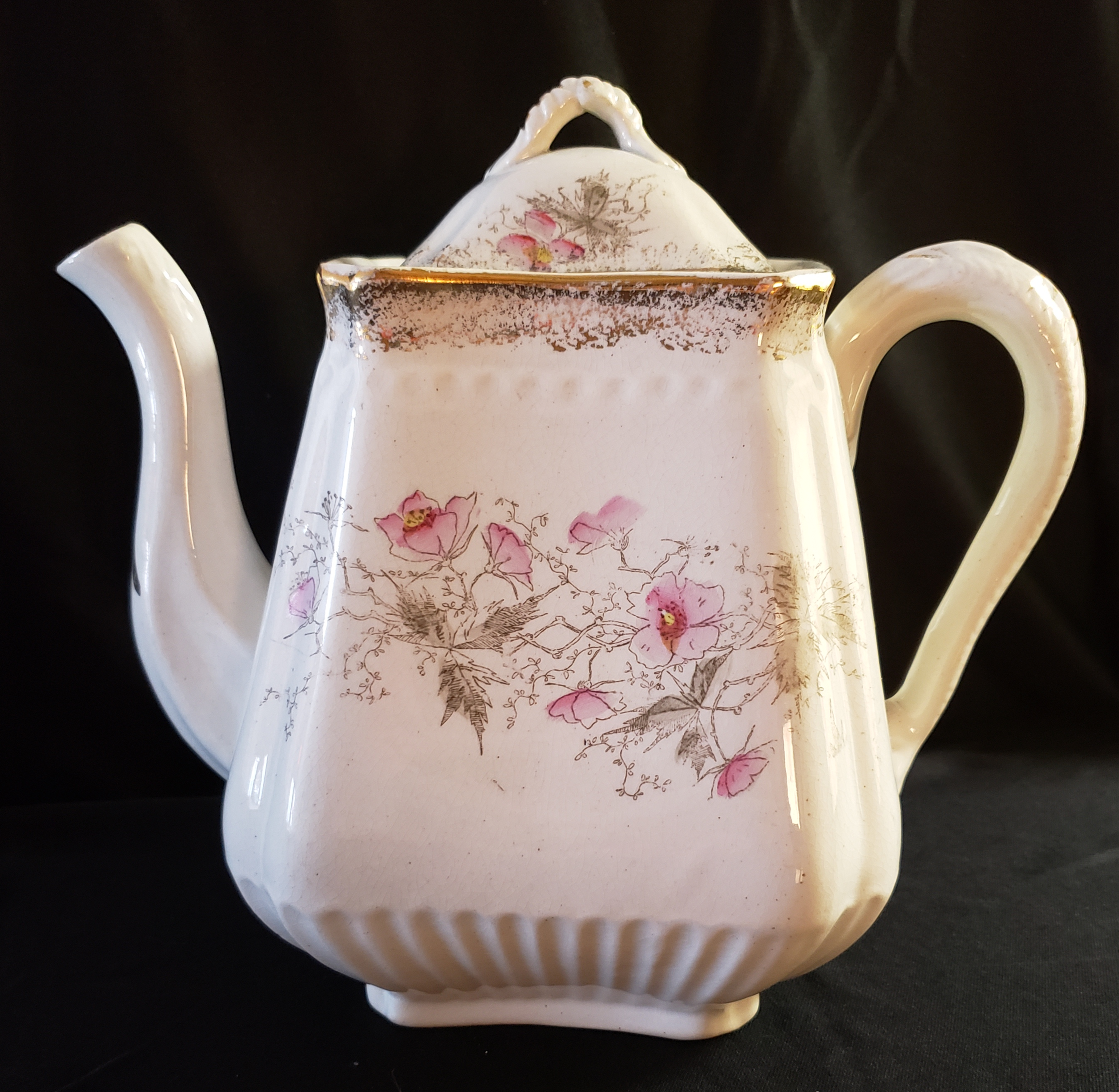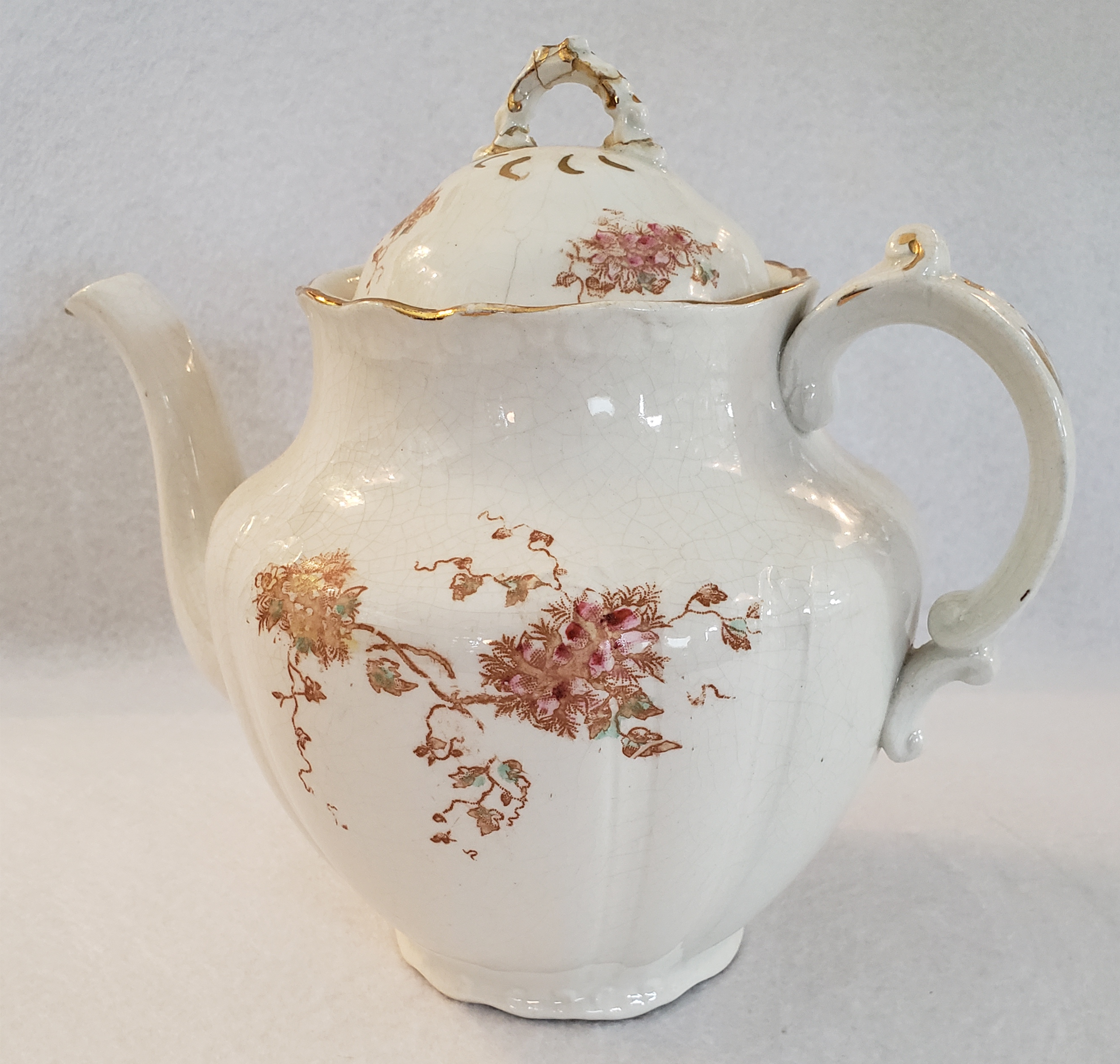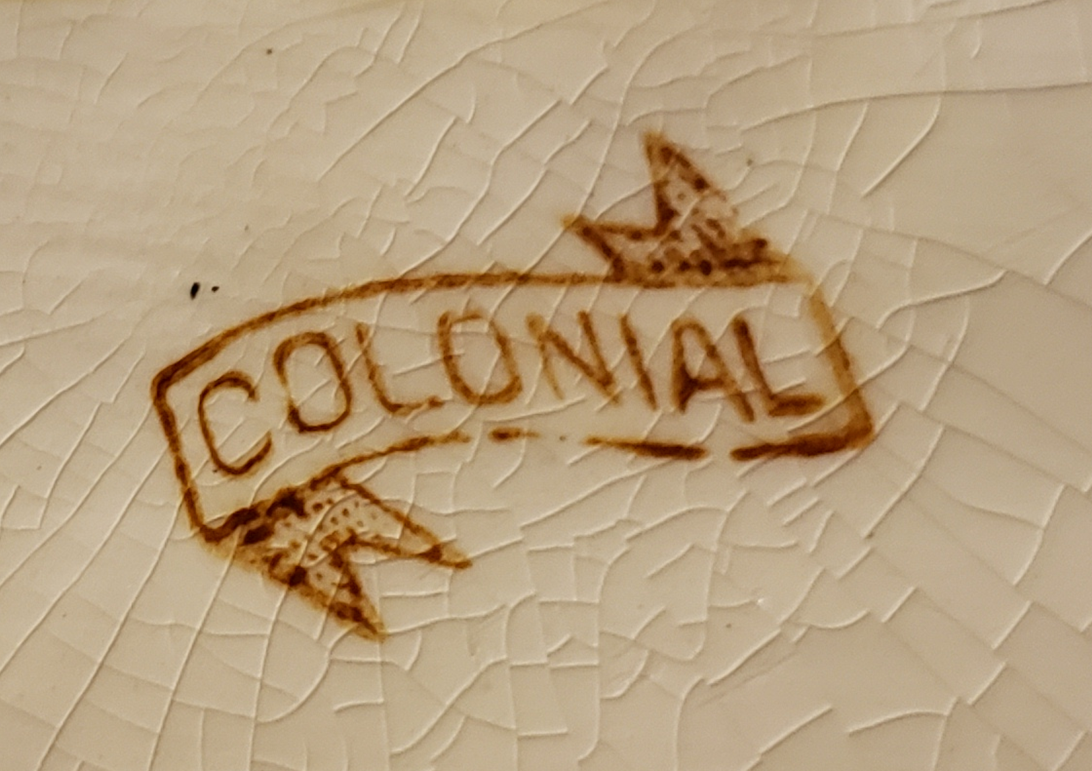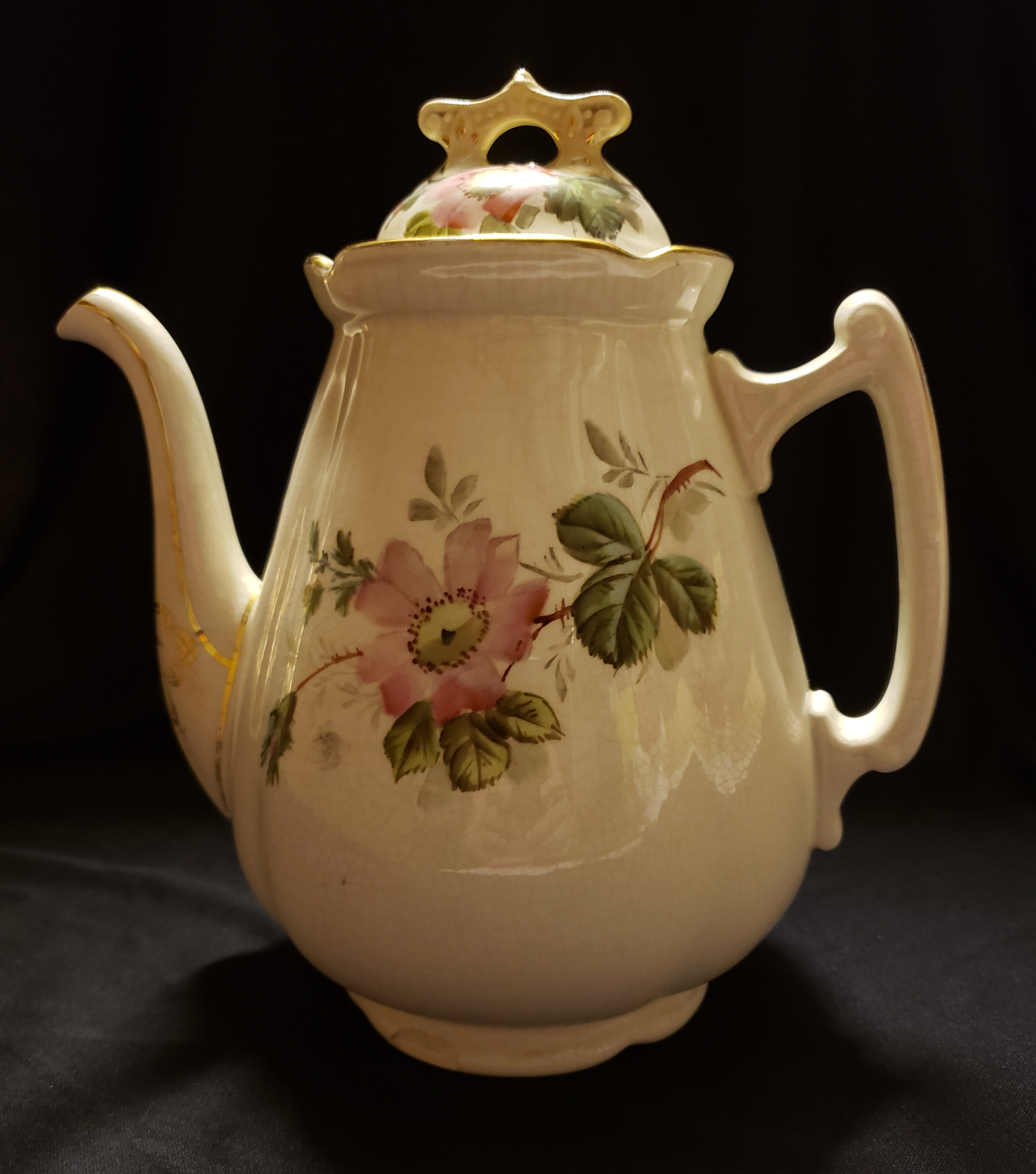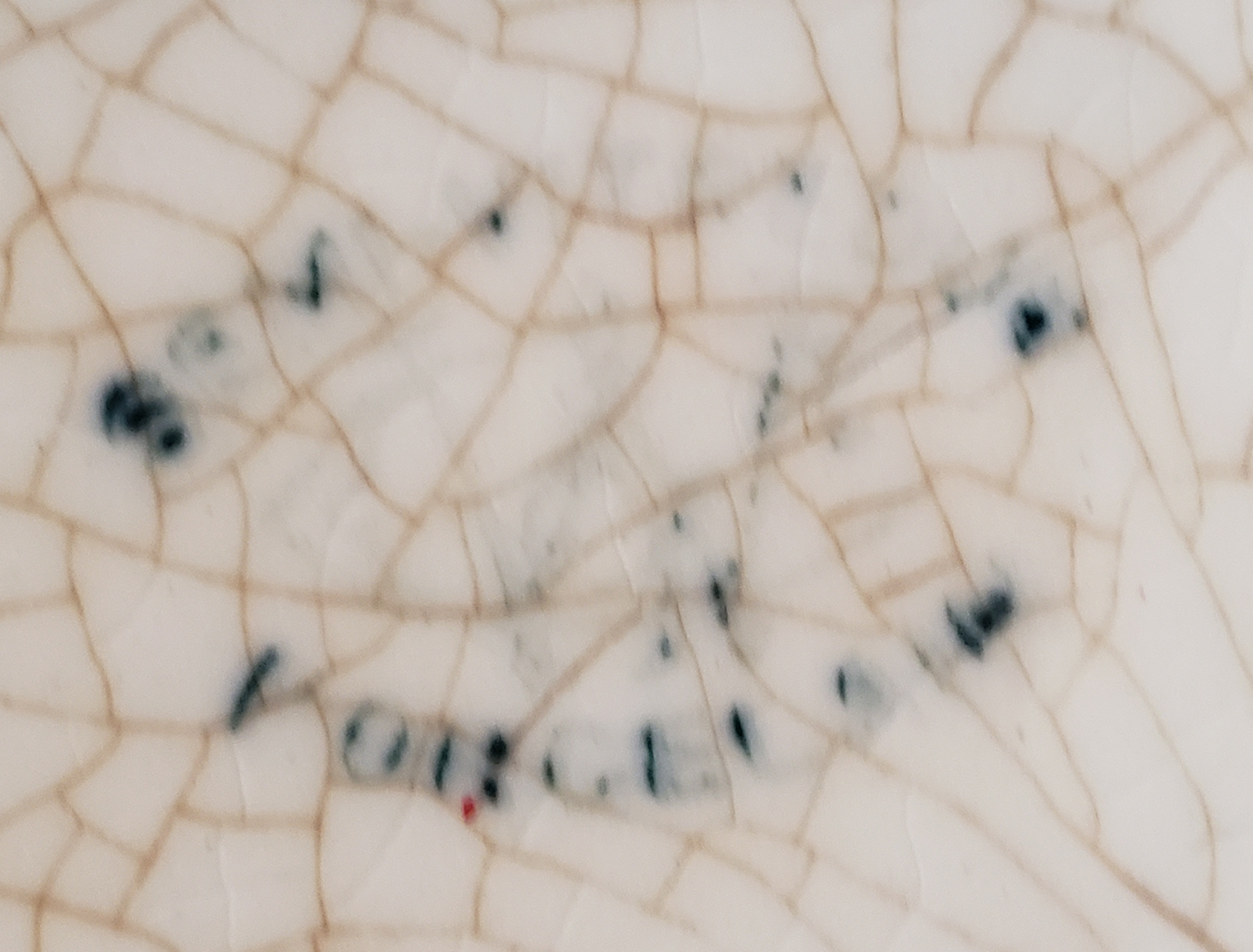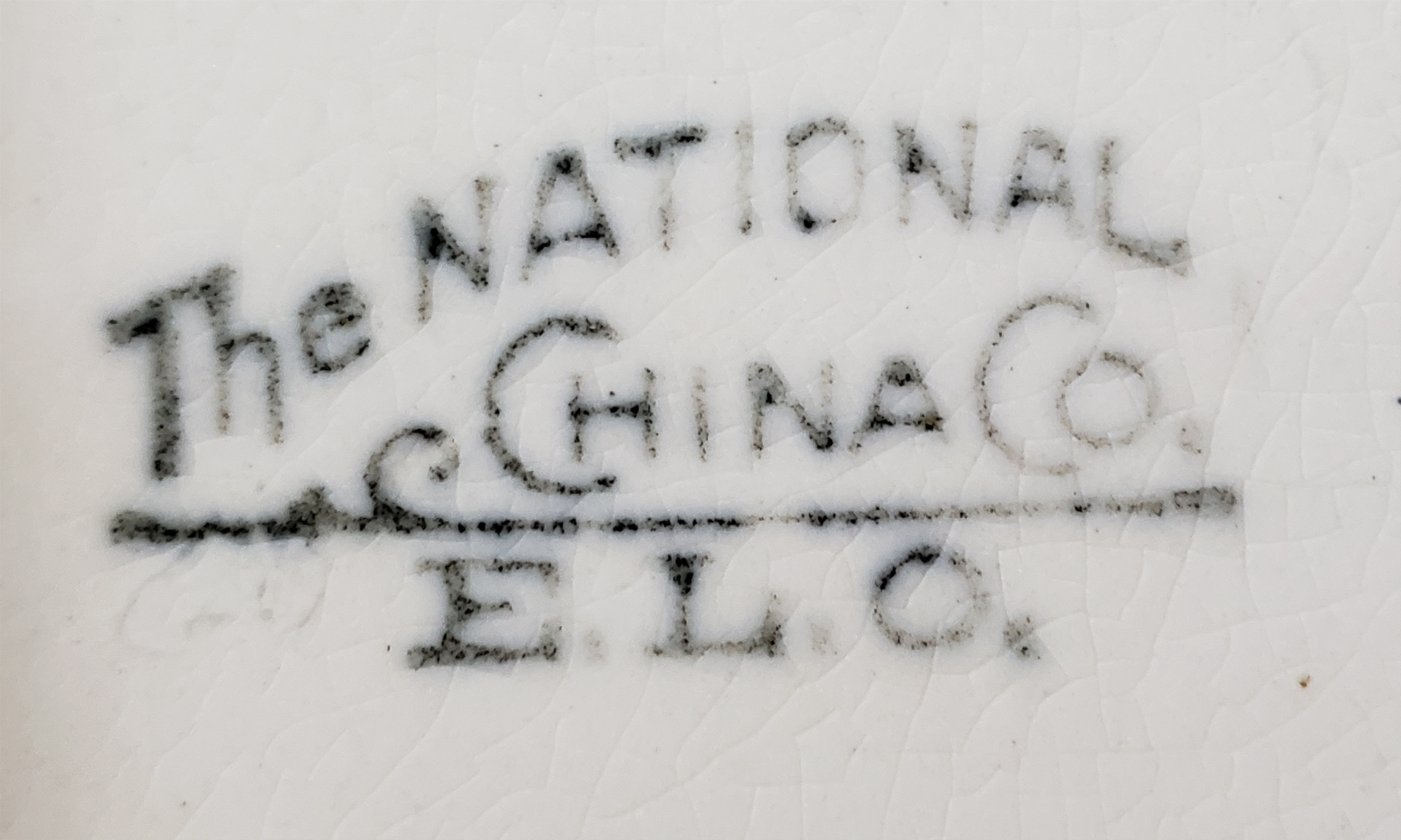Gallery ~ 4
D. E. McNicol Pottery Company
TITLE: Ursula
MAKER: D.E. McNicol Pottery Company
DATE: 1892 - c.1910
COLLECTION: Museum of Ceramics/Ohio History Connection H80
On December 23, 1898, in the Daily Crisis, it was announced that the D. E. McNicol Pottery Company was preparing a new dinner shape for the following year. It would have a high foot with bodies that “are handsomely molded and are beautifully adapted for flowers or gold decorations or both.” Called the Ursula, this example, believed to be in that style, has a transfer design.
The image from the copper engraving plate, pictured here, was “used to print the design on tissue sheets. The designs were then transferred from the tissue to the ware”.
detail of a copper engraving plate
TITLE:
MAKER: D. E. McNicol Pottery Company
DATE: 1897-1915
COLLECTION: William and Donna Gray
Daniel E McNicol was born in East Liverpool, Ohio in 1855
Daniel worked in the McNicol, Burton pottery with his father. In 1892 he became president of the company and it was incorporated as the D. E. McNicol Pottery Company. The company was the last in East Liverpool to make yellowware using the local clays. They continued this practice until 1927 when they moved production to their plant in Clarksburg, West Virginia in 1928. (Gates, 2009).
T
TITLE:
MAKER: D.E. McNicol Pottery Company
DATE: 1897-1915
COLLECTION: William and Donna Gray
The D.E. McNicol company was well known for the high quality and diversity of their wares. In the June 17, 1896 issue of China, Glass and Lamps, an advertisement for the company states, “the following is a broad assertion but nevertheless true…We are making the Best Quality, Color, Finish, latest and most attractive Shapes and Decorations of any goods in our lines on the market.” The advertisement also states that they are “manufacturer of C. C (cream colored). Semi-granite, plain and decorated, also Rockingham and Yellow Ware, and Enameled Tea Pots and Cuspidors (spittoons).”
McNicol, Smith Company
TITLE: Colonial
MAKER: McNicol, Smith Company
Date: 1900-1907
COLLECTION: Museum of Ceramics/Ohio History Connection H413_007
D. E. McNicol and William Smith set up their pottery in Wellsville, Ohio and were in production from 1889 to 1911 when Smith decided to leave the partnership to concentrate on his interests in the Taylor, Smith and Taylor. (Gates, 2009).
Wallace and Chetwynd
H. D. Wallace and Joseph Chetwynd purchased the “Wedgewood” pottery from the Harker Pottery Company in 1881. In 1882, they began production in the newly named “Colonial” pottery. The company’s philosophy was quality over quantity and they were well-known for the high quality of their product. In 1884, they announced an underglaze printing technique that would be used on all future ware. In 1901 Wallace and Chetwynd joined the ill-fated East Liverpool Potteries Company. (Gates, 2009).
TITLE: Clement
MAKER: Wallace & Chetwynd Company
DATE: c1890
COLLECTION: William and Donna Gray
Clementine Chetwynd, recently married to Joseph, and relocated from Wheeling, West Virginia to East Liverpool, was escorted to the pottery and lit the fire in the first kiln to run for Wallace and Chetwynd. (Cox, 1940).
TITLE: Wedgewood
MAKER: Wallace & Chetwynd
DATE: 1882-1901
COLLECTION: William and Donna Gray
It is recorded, that Joseph Chetwynd, and his brother Jesse, were the designers of the Cable shape of pottery. This very popular shape was copied and used by many manufacturers in the East Liverpool district and the early American pottery industry. (Barth, 1926).
TITLE: El Dorado
MAKER: Wallace & Chetwynd Company
DATE: 1882-1901
COLLECTION: William and Donna Gray
Tea Trivia:
Tea has numerous health benefits including lowering the risk of strokes, cancers, osteoporosis, lower risk of depression, reduced chance of heart disease and a lower risk of diabetes. Chrysanthemum tea is reportedly a favorite herbal tea in Korea and China. It is used to help reduce fevers and cure headaches. Ginger tea, which can be made with fresh or ground ginger, is drank to help with colds and morning sickness. Tea contains polyphenols, antioxidants that repair cells and are said to aid the immune system. For centuries, tea was used mainly for medicinal reasons; it took about three millennia for it to become a common, everyday beverage. (Chamberlain, 2019).
TITLE:
MAKER: Wallace & Chetwynd
DATE: c 1890
COLLECTION: Museum of Ceramics/Ohio History Connection H36
In the late 19th century the East Liverpool pottery district was expanding across the Ohio River into Chester, and Newell West Virginia, and northward into Columbiana and Mahoning Counties in Ohio. There was also a transition to products called whiteware. The potteries called this type of base pottery, ironstone, granite, white ironstone, porcelain, semi-porcelain and other names to differentiate themselves from competitors and to distinguish new processes from old. Whiteware has a stronger but thinner body and allowed for more ornate molding and decoration. This example is simple in decoration and is an example of the transition.
East End Pottery Company and East End China Company
TITLE:
MAKER: East End China Company
DATE: 1908
COLLECTION: Museum of Ceramics/Ohio History Connection H471
The East End China Company was located on the northside of Railroad Street and east of Boyce Street in the East End area of East Liverpool. The company formed from the East End Pottery Company that had joined the East Liverpool Potteries Company in 1901. After the failure of the cooperative in 1903, the company resumed production under the original name. In 1908, the name was changed to the East End China Company. In 1909, Gus Trenle assumed control and changed the name to the Trenle China Company. (Gates, 2009)
TITLE:
MAKER: East End Pottery Company
DATE: 1894-1901, 1903-1907
COLLECTION: William and Donna Gray
Child size
The East End Pottery Company was the first pottery company to locate in the East End area of East Liverpool. Other potteries would soon follow. The company was organized as a cooperative and sponsored by the East Liverpool Board of Commerce. The company was offered a $2000 bonus and an acre of land. Construction of the two kiln pottery was completed in October 1894 with production delayed until 1895. In 1901, six local potteries, including the East End Pottery Company, merged to form the East Liverpool Potteries Company. The venture was short-lived and the merger dissolved in 1903 with the East End Pottery Company resuming production under the pre-merger management. (Gates, 1984).
TITLE:
MAKER: East End Pottery Company
DATE: 1894-1901, 1903-1907
COLLECTION: William and Donna Gray
Tea Trivia:
Charles Elmer Hires, a pharmacist, created root beer while attempting to recreate an herbal tea that he had enjoyed on his honeymoon. His new concoction was a combination of “25 herbs, berries, and roots” that flavored a carbonated drink. The drink was unveiled to the masses at the 1876 Philadelphia Centennial exhibition and was a great success. (Bellis, 2019).
TITLE:
MAKER: East End Pottery Company
DATE: 1894-1901, 1903-1907
COLLECTION: William and Donna Gray
Child size. Lid may not be original to the piece.
Tea Trivia:
There are four major types of tea - black, green, white and oolong and they all come from one plant, Camellia sinensis. The treatment of the leaves creates the different types of tea. (Kenna, 2021).
Sevres Pottery
TITLE:
MAKER: Sevres Pottery
DATE: 1900-1908
COLLECTION: William and Donna Gray
The Sevres China Company was a short-lived partnership formed in 1900 by Harry Keffer, Frank Crook, William Tebbutt, Walter Hill and William Deidrick. They had purchased the Sebring Brothers plant number 1; the Sebring brothers had relocated their pottery works to what is now known as Sebring, Ohio. Even though both Keffer and Deidrick were experienced potters and there was financial support, Tebbutt, Hill and Crook left the partnership. In 1908, J. R. Warner joined Harry Keffer to reorganize the company as the Warner-Keffer Company. (Gates, 2009, Calhoun, 2020).
TITLE:
MAKER: Sevres Pottery
DATE: 1900-1908
COLLECTION: William and Donna Gray
In 1900 the pottery industry in East Liverpool was flourishing. However, according to William Tebbutt, a partner in the company, there was a shortage of skilled potters. In a letter to England in 1900 he encouraged the emigration of skilled English potters to the USA, stating that the Sevres Company, alone would need 50 men by July of that year. (Gates, 1984).
The GENEVA mark, seen here, was a variation on the SEVRES mark, seen above, used by the pottery of that name.
(Gates, 2009).
National China Company
TITLE:
MAKER: National China Company
DATE: 1899-1911
COLLECTION: William and Donna Gray
The National China Company was formed when a $5,000 bonus and land was secured along the railroad line. The five kiln pottery began production in 1900 with a potential workforce of 150. J. H. Warner, later of the Sevres and Warner-Keffer potteries was a founding partner in the National China Company. In 1911, The National China Company moved production to Salineville, Ohio. (Gates, 1994, 2009).


